How to Connect Multiple Tv to One Dish Receiver
Connect multiple TVs. How to connect a second TV to a satellite receiver
There are many different TV programs so that each family member can watch the one that he likes, the question arises of installing a second or several TVs. How to solve it yourself and connect to an existing or additional television sets.
How to connect multiple TVs to one antenna? To do this, in the existing cable make branching, using the usual tee, which is inserted into all the cores. Then they attach the first TV and connect in addition. But this method leads to a violation of the agreement in the antenna cable itself and the mutual influence of the televisions on each other. This method reduces the signal level, there is a lot of noise on the screens, so no one uses it.
To connect additional TV, if there is only one antenna, use splitters (crabs). A splitter is a cable splitter with three or more resistances in its case, as well as outputs for TVs.
What are splitters
Splitters coordinate the wave resistance, maintain the signal, not letting it fade, it eliminates noise and interference, improving the image.
Antenna crabs divide a cable into two or more televisions, they are:
- passive;
- active.
Such splitters have one input and several outputs, usually for a house they choose on 2 or 3 TVs. They evenly share the signal from a common antenna.. For example, the input is 12 dB, which means that the antenna splitter installed on 2 TVs will generate signals from each of the outputs of 6 dB. If we install a splitter on 3 outputs, this will be 4 dB each. In the circuits of passive separators are used transistors, or transformers.
When buying a crab, one should pay attention to its characteristics, namely:
- bandwidth;
- number of exits;
- attenuation level;
- the presence of the RF amplifier.
Also pay attention to the range of frequencies that it can pass. If this is a high satellite bandwidth of 5-2400 mNz, then it is suitable for on-air TV. But 5-1000 mNz can only be used for on-air TV, it must be taken into account.
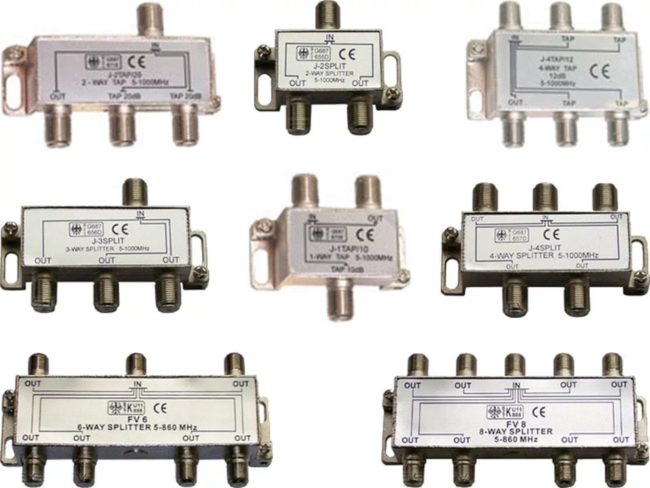
Splitter has from 2 to 8 outputs. When buying it for only 2 TVs, think about the possible connection of additional receivers in the future. Pay attention to the level of attenuation, the smaller, the better.
The splitter, which has a built-in RF amplifier, is called active, and is able to maintain and boost the signal, but it is necessary to connect power to it. This can be a separate unit or by cable.
Connect using splitter
With a high signal level, passive crab is used to connect two TVs. To do this, you need a quality cable (RC-75) with a small attenuation, the less decibels indicated on it, the better, and the characteristic impedance should be 75 Ohms with a frequency of up to 1000 MHz.
Connection diagram is simple. The splitter input and the cable from the antenna are connected together, and its outputs are connected to TVs. With a bad image, you need to check all the connections and the integrity of the cable itself.
Connection process
To make the connection process easy for everyone, consider it in more detail:
- prepare a splitter with built-in jacks for coaxial cables, F-connectors and cable;
- choose the installation location of the crab, and this is the shortest distance to 2 or 3 televisions;
- we cut the cable from the antenna so that it freely reaches the crab;
- install the F-connector.
Disconnect the TV from the mains. For each prepare pieces of cable. We begin to install connectors. This is done in this way:
- remove 1.5-2 cm of upper cable insulation;
- we pull back the silver screen;
- we clean the central wire;
- cheat F-connector.
If the central wire protrudes more than 3 mm, it must be cut off. Now connect the cable from the antenna to the crab. In the same way, we connect each output of the splitter and the TV set.
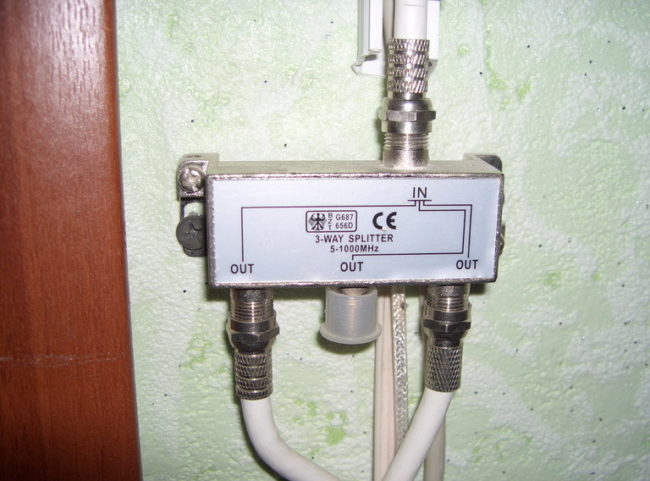
Connection by active splitter
Connect two televisions to the existing one antenna, preferably an active splitter, so they are replaced by passive crabs. In order for the amplifier antenna to improve the quality of the signal by 2 or 3 TV at the output, one of the receivers is connected to a power supply with a filter, preferably with a regulator. The second exit, to the next TV.
Perhaps in the future it will be necessary to connect a third TV or set-top box, then you need to set the crab to 3 or 4 outputs, you will have to connect 75 Ohm ballast resistors to the emergency outputs.
To simultaneously receive analog and digital TV you need to connect to the DVA-T2 console. To do this, connect it to the free exit of the crab, and after digital cable HDMI or bells connect one of the TVs.
Connecting TVs to a satellite dish
Such a television uses a system of orbiting satellites, including the last third-generation meridian and others that are in space. Television stations give them a signal, and they return it to large areas of the earth, where each satellite dish receives it and reflects on the collecting head, receiver and television. So, on the screen appears the image and sound. And you can.
Previously, to buy a satellite dish, they bought 1 set of equipment designed for one telly. Time passes, the owners acquire a second TV, wanting to connect to an existing cable. There is a problem how to connect two TVs to satellite dish on their own. Read about the article.
There are only 2 ways to connect TVs to one satellite dish, the first is the use of an RF modulator, the second is the use of 2 or 3 receivers, that is, separate for each TV.
HF modulator application
We use the existing tuner, connect the first TV to the tulip, linking it with the RF modulator, then the second monitor. With one receiver you can connect 2 or 3 TVs, this number depends on the outputs that are on the rear panel. This method is simple, but the financial costs are small.
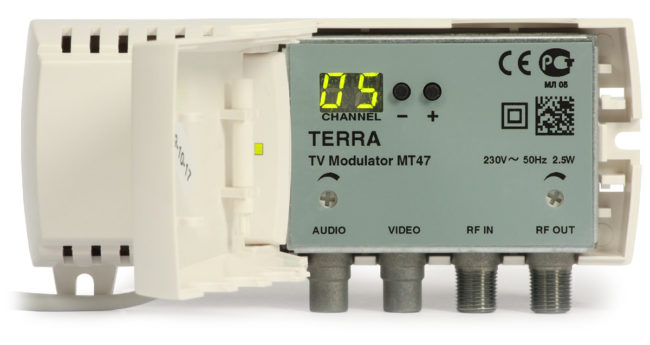
Switch channels, perhaps, but only on the tuner, which can stand in another room. Another disadvantage of this method is that both TV shows one channel. The picture quality of the TV connected directly to the receiver will be better than on the others. As you can see, this method has many disadvantages. Therefore, it is advisable to use additional receivers, but it is expensive.
The use of additional receivers
This method involves the installation of an additional 2 or 3 or more satellite tunersone by one to the room where the TV is installed. Now, each telly will provide independent selection and viewing of the desired channel. Also read about and
But this connection system requires the installation of electronic convectors, in which the number of outputs corresponds to the number of tuners. The most common heads have 2, 4 and 8 outputs, if you need even more used multiswitch, usually it is used for apartment buildings.
The most crucial moment here is the choice of the receiver. Some may not support certain parameters, so not all channels will be available to the user. An ordinary person is difficult to understand the huge number of complex devices, so you need to trust a specialist. The correct decision and the choice of a suitable method will make it possible to ensure the maximum number of TV channels with a high-quality image.
Owners of several TVs in the house often wonder how to divide the signal and not degrade the quality of the broadcast. Competently selected and connected antenna splitter creates a cable cable distribution structure from a single source without significant loss of signal power.
Kinds
There are several types of antenna splitters, but they all have a similar external device, consisting of a metal case and connectors for connecting the cable. On the case there is necessarily a marking of connectors:
- Input (IN) - for the cable entering the room.
- Output (OUT) - for the cable connecting the antenna splitter with each of the TVs.
According to their purpose, antenna splitters are divided into:
- Dividers (splitters), through which the TV signal is evenly divided into several outputs. Used for cabling around the house or apartment.
- Taps (TAP), differing from dividers by the presence of one pass-through output. This output allows you to consistently connect to it another coupler without loss of quality. Designed to organize television network in an apartment building.
It is worth paying attention to the important property of dividers to pass the signal in the opposite direction and be used as adders. This quality allows splitters to mix signals from several antennas of different frequency ranges into one cable, if their frequency specifications allow.
Specifications
When selecting any equipment, it is necessary to proceed both from the characteristics and the individual characteristics of its installation in a particular situation. Do not become an exception and antenna splitters. How to choose the correct divider in its parameters?
Characteristics of the antenna splitter:
- Bandwidth. Shows the frequency range transmitted by the divider. For terrestrial TV, the operating frequency of the divider should be in the range of 5-1000 MHz, for satellite TV - from 5 to 2500 MHz. A satellite splitter can be used to transmit digital and analogue terrestrial signals.
- The number of exits.An antenna splitter can include up to eight. Choose equipment based on the number of connected TVs. You can connect a splitter with a large number of outputs for expanding the television network.
- Attenuation levelAn important indicator that determines the amount of decrease in the power of the transmitted signal. The smaller this figure, the more insignificant the output losses will be.
- The presence of the RF amplifier.An antenna splitter with built-in RF amplifier is called active. Such a divider can not only save the power of the incoming signal, but also increase it. It is worth considering the need to connect the power for the active divider.
If you intend to divide the signal into two televisions, it is enough to purchase a passive splitter with two outputs and good tv cable. Attenuation will be 3-3.5 dB at each output, which will not have a significant impact on quality.
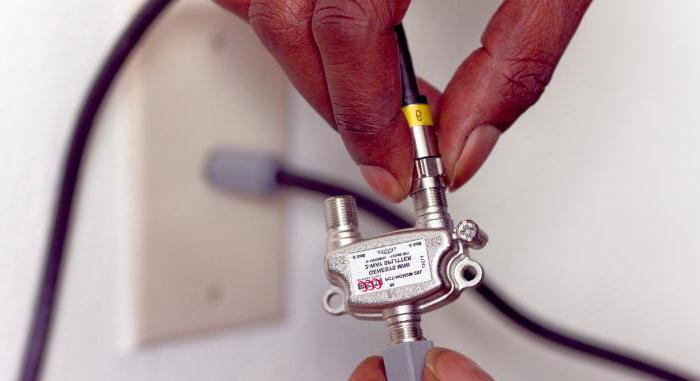
If the plans divide the signal into three or more TVs, then for the selection of the amplifier it is necessary to draw up a wiring diagram so that the input signal to each TV has the same signal level. Be sure to consider the attenuation level not only in the divider, but also in the cable. The use of an active amplifier in this case ensures a reduction in losses from separation, length and quality of the cable used.
DIY antenna splitter
The antenna splitter circuit does not contain anything complicated, and it is technically quite possible to make it yourself. Any divider consists of a bridge with a ferrite transformer and capacitors. But is it worth the trouble? The manufactured device will be suitable only for dividing the analog television signal, and ferrite rings can only be found in specialized stores.
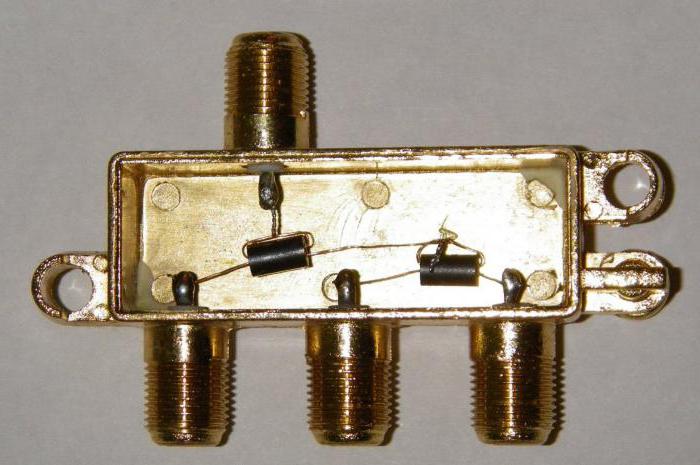
It makes sense to constructively modify an inexpensive Chinese-made antenna splitter or turn the passive divider into an active one. Many Chinese manufacturing manufacturers save on installing additional resistors and SMD capacitors. The best option would be to buy a divider of proven brands such as Alda, Rexant or Lans.
As a rule, one digital set-top box is designed to connect one TV. If there are several TVs and all of them do not support the DVB-T2 standard, a separate receiver should be connected to each TV. Despite the low cost of consoles, many people want to minimize costs and use one set-top box for at least two TVs. This is possible, but with certain limitations:
- One of the TVs must have a digital HDMI input (in the old CRT TVs it can not be).
- Both TVs will show the same picture, view different digital channels in this case is impossible.
- Channels are switched on the console from the console, and the console works only in the line of sight of the console. That is, if you watch TV in one room, and the console is in another, you will need to go to another room every time you switch channels.
A typical example of such a scheme is when one person watches channels with digital set-top boxes alternately in different rooms, for example, in the room and in the kitchen, and at the same time does not need to constantly switch channels. However, with a good arrangement of the premises and good reflective surfaces, the signal from the console can "fly" to another room through the open door.
Connection scheme DVB-T2 set-top boxes for two TVs
If the above restrictions do not scare you, then connect digital receiver possible according to the scheme shown in the figure. The first TV, with HDMI input, is connected with an HDMI cable to the corresponding output of the console. The second TV is connected by a prefix using an RCA cable, which is usually called "tulips".
If the distance is short, you can use ready-made RCA cable of the desired length (usually they are no more than 5 meters). If it is not possible to buy a ready-made cable, you can purchase RCA plugs and use an ordinary cable for signal transmission. To transfer images with stereo sound, you will need three cables, for mono sound, two will suffice. We recommend using the plugs shown in the picture. They are reliable, easy to use and do not require any tool other than a knife when installing. Initially, an F-connector is installed on the cable, and then an RCA-plug is screwed into it.
Instruction
If your TV can show the frequency of received channels through the menu, find out this data about all the programs you are receiving. Find the channel with the highest frequency. Choosing splitter, make sure that the upper limit of the range is greater than this frequency. If there is no frequency display feature on the TV, it is useful to take the device with this capability from your friends for a while.
The number of outputs at the splitter must exceed the number of televisions you have. If in some of the rooms you have no television receivers, it is useful to take the device "for growth" with additional outputs. In time, you may also purchase televisions for these rooms.
Pay attention to such a parameter as attenuation. It is expressed in decibels. Its value is indicated on the housing of the splitter or in its instructions. The smaller it is, the better.
Decide in advance how and where you will install the splitter. It is highly desirable to fix it on the wall, and not leave to stick on the same cables - and more reliable and beautiful. In this case, the device must have mounting holes. If the device is located in a prominent place, it should have an aesthetic appearance. In case, if you are going to install a splitter inside a wide cable box, it should have minimum dimensions.
The method of connecting the device, choose in accordance with the types of cables used, as well as your soldering skills. Splitter with screw terminals compatible with cables of any diameter, and does not require soldering. It will not be necessary to install the device with threaded connectors, but only thin cables can be connected to it. If you have soldering skills, buy a splitter designed for connection in this way. Finally, a device equipped with coaxial jacks (like on a TV) can be connected to any cables using ordinary antenna plugs. Buy the plugs yourself in the same store, and choose the type depending on the availability of soldering skills (some of them allow the cable to be attached with screws).
When you buy, do not confuse a splitter with another device of a similar purpose: a combiner or separator of signals of different ranges. Some older TVs have separate inputs for antennas meter and decimeter range. Next to such a device, you will have to position a signal splitter, which allows you to connect both inputs to the same antenna cable.
To choose the right antenna cable, you need to study his technical passport, as well as insulation and braid. It is necessary to pay attention to the service life, resistance and attenuation indicators.
You will need
- A piece of cable with markings, his technical passport.
Instruction
Read the cable label carefully. It is important that its central core be made of copper or copper-coated steel. Thereby cable will have rigidity and good performance.
Remove the top insulation layer and check the braid density of the central core screen. The more thin wires in the sheath, the tighter the screen, the less there will be interference during its operation.
Pay attention to the passport data cable. The lower the attenuation value of a TV signal at a certain frequency and cable length, the better the conditions of a television broadcast.
note
For the antenna use a cable with a resistance of 75 Ohms. If the resistance is lower than this indicator, the cable can only be used for radio transmitters and computer networks. At resistance values higher than 75 Ohm, the cable is suitable for matching the receiving antenna with the feeder.
Signal attenuation of 70% means that the cable has expired. Choosing a product, pay attention to the data of the technical passport, where the information on the working life of the cable is indicated.
Thin cable is not suitable for the antenna. It can only transmit a limited number of channels, and its shielding capabilities are scanty.
Cable RK-75 is obsolete, it has a high attenuation rate.
Buy cable only in specialized stores.
Helpful advice
TV cable always has a round shape. For cable operating in the UHF and UHF bands, it is preferable to use braid and foil, as well as tubular polyethylene or polyvinyl chloride insulation, gel moisture-proof filler. This will improve the operating conditions and reduce the level of interference with the TV signal.
Sources:
- Recommendations for selection antenna cable
The second and even the third TV at home is not a luxury, but an integral part of a comfortable life. But in order to enjoy it fully, you need to properly connect the antenna splitter.
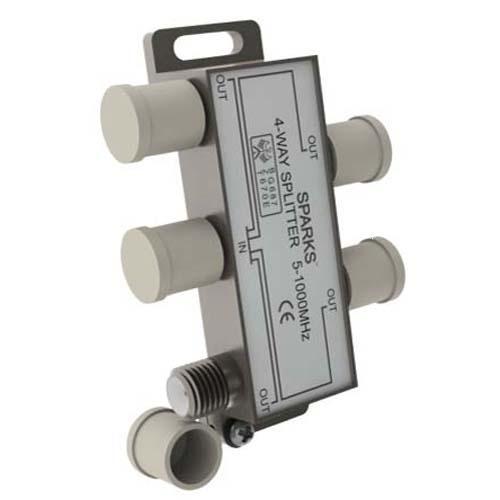
You will need
- - antenna splitter;
- - cable television;
- - plugs;
- - a knife.
Instruction
Select the place where you plan to install the antenna splitter. Mark the location of the future location of the splitter and your television receivers.
Take a tape measure and measure the distance to each of the TVs that you will connect. Record the result. Add the measurement results. You got the total cable length. Add to this number a couple of meters for insurance.
Buy the right amount of cable, as well as everything you need: splitter, plugs (according to the number of TVs), mounting brackets (if you are going to mount the cable to the wall). When buying, check whether the internal diameter of the splitter's nuts matches the outer diameter of the cable.
Cut the cable into pieces according to your size. Using a sharp knife, remove the outer sheath from the end of the cable. Separate the screen from foil and braid from the center and bend it on the uncleaned part of the cable. Take care not to accidentally cut them. Also remove the insulation from the center of the cable.
Slide the splitter nut onto the end of the cable. Bend the screen and braid. Insert the center conductor of the cable into the socket of the splitter and tighten the nut. Repeat these steps for the rest of the cable. Secure splitter in the selected location.
Route each piece of cable to the television for which it is intended. If necessary, secure it using purchased staples or put them in the cable channel of the plinth.
Install the plug on the free end of the cable. To do this, prepare the cable as described above. Put on the cap of the plug. Bend the screen and braid. Insert the center wire into the hole of the plug and secure with a screw. Braid crimp around the cable sheath bandage. Screw the cap onto the case. Insert the plug into the antenna jack on the TV.
Turn on all TV sets to evaluate the quality of reception. If it does not meet your requirements, you must install an antenna amplifier.
Related videos
Helpful advice
Instead of a knife, you can use a special cable cutter.
If you want more television in your home, we recommend reading this article. In it, you will learn how to connect two televisions to one receiver yourself.
What is important to know when connecting
This connection can be made in several ways, and this will depend on the model of the receiver. However, remember that watching different channels on two TVs at the same time is not possible, and you can only watch one channel on two TVs. This can cause discomfort, especially if there are two TVs in the same room, because you can only switch channels directly next to installed receiver. But this problem is solved simply: you need to buy a remote control. Well, now proceed directly to the instructions.
Connect with RF cable
The second TV is simply connected to the receiver using an RF (high-frequency) TV cable via the RF OUT output, which is located on the back of the device. You will need a regular TV cable with input and output plugs. One end is inserted into the output of the receiver RF OUT, the other is connected to the antenna TV jack (it can be located on the back of the TV). That's all: it remains to search for TV channels (for which you need to go to the settings menu of your TV).
Connecting the receiver to multiple TVs
Newer models of receivers are often not equipped with a high-frequency modulator and RF OUT output. To connect multiple TVs to this receiver, you will need:
- portable RF modulator;
- tulip cable (RCA woofer cable, usually this cable comes with the device);
- coaxial TV cable 75 Ohm required length;
- F-connectors and F-plug input.
The modulator has its own power supply, and it needs another connection point at 230V. The connection steps are as follows: connect the tulip cable to the RCA output connector on the back of the receiver, and connect the other end to the RCA input of the modulator. If your device does not have an RCA output, then you can use a SCART-RCA cable.
Next, connect the TV cable to the RF OUT output (on the modulator) using the F connector, and on the RF IN input (marked this way most often) screw the special 75 OM plug (supplied in most cases with the device). Connect the opposite end to the IN connector of the divider. With the help of the divider, the signal can be divided into several TV devices in the room, since this equipment has more than one output. It remains only to connect all the equipment to the power source and to auto scan TV channels (as in the first connection method).
Connect with RCA cable
This method is suitable for owners satellite equipment with support for multiple video outputs (HDMI and RCA). If one TV is connected hDMI cable, then you can use the RCA or SCART outputs to connect a second one. Just remember that to connect to the SCART connector, you have to use the SCART-RCA adapter. Next, using the remote control, switch the input signal (AV or SOURCE) on the TV you are connecting.
You may notice that this connection is much easier to make than the previous ones, because there is no need to spend money on the purchase of a DX modulator. But this connection has its own minus, and this is a limited cable length - only up to 15 meters (as with a longer length the image will disappear and the quality will deteriorate significantly), as well as the availability of a long cable, since it may have to be soldered from several.
How to Connect Multiple Tv to One Dish Receiver
Source: https://promstall.ru/en/tv/connecting-multiple-tvs-how-to-connect-a-second-tv-to-a-satellite-receiver.html
0 Response to "How to Connect Multiple Tv to One Dish Receiver"
Post a Comment